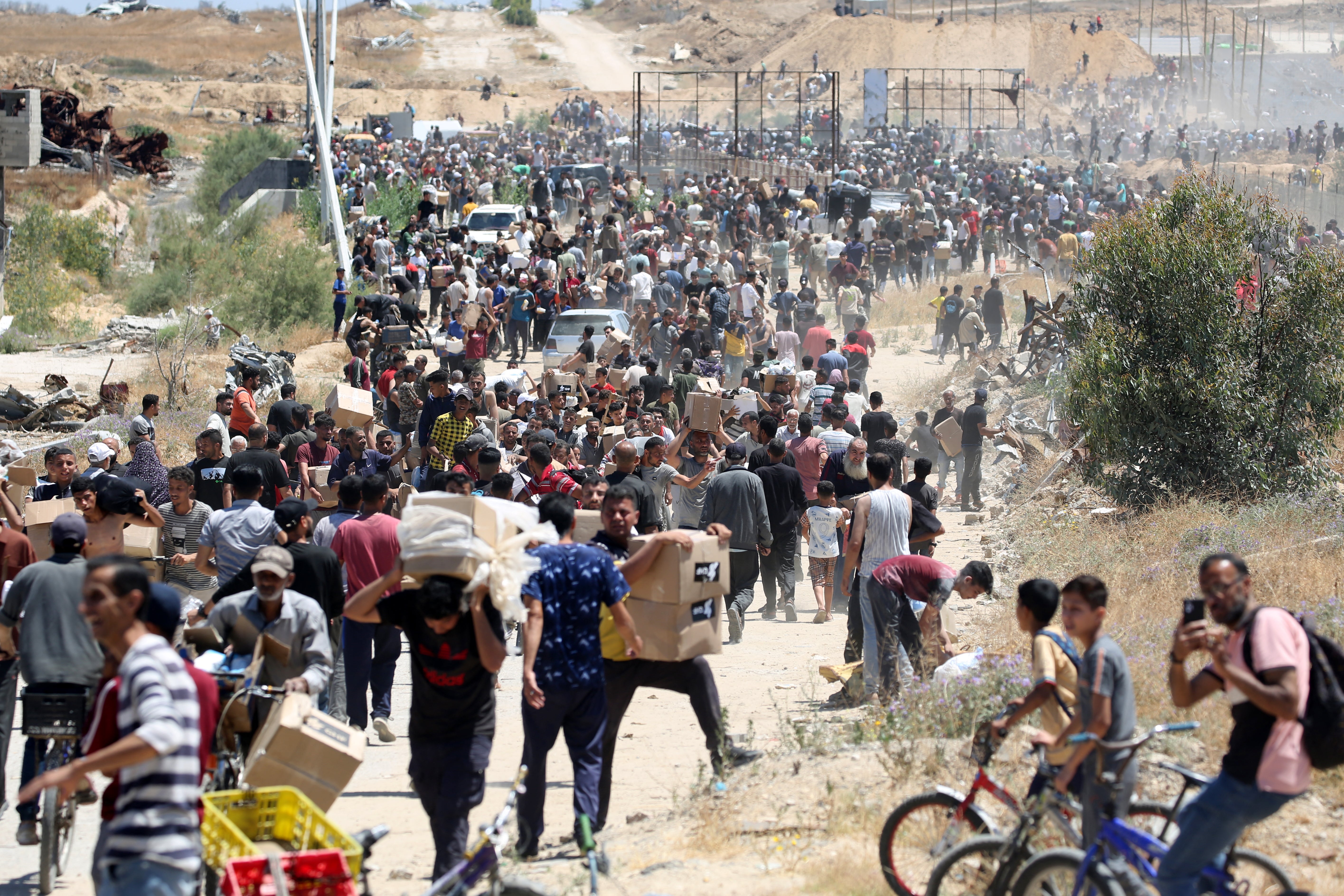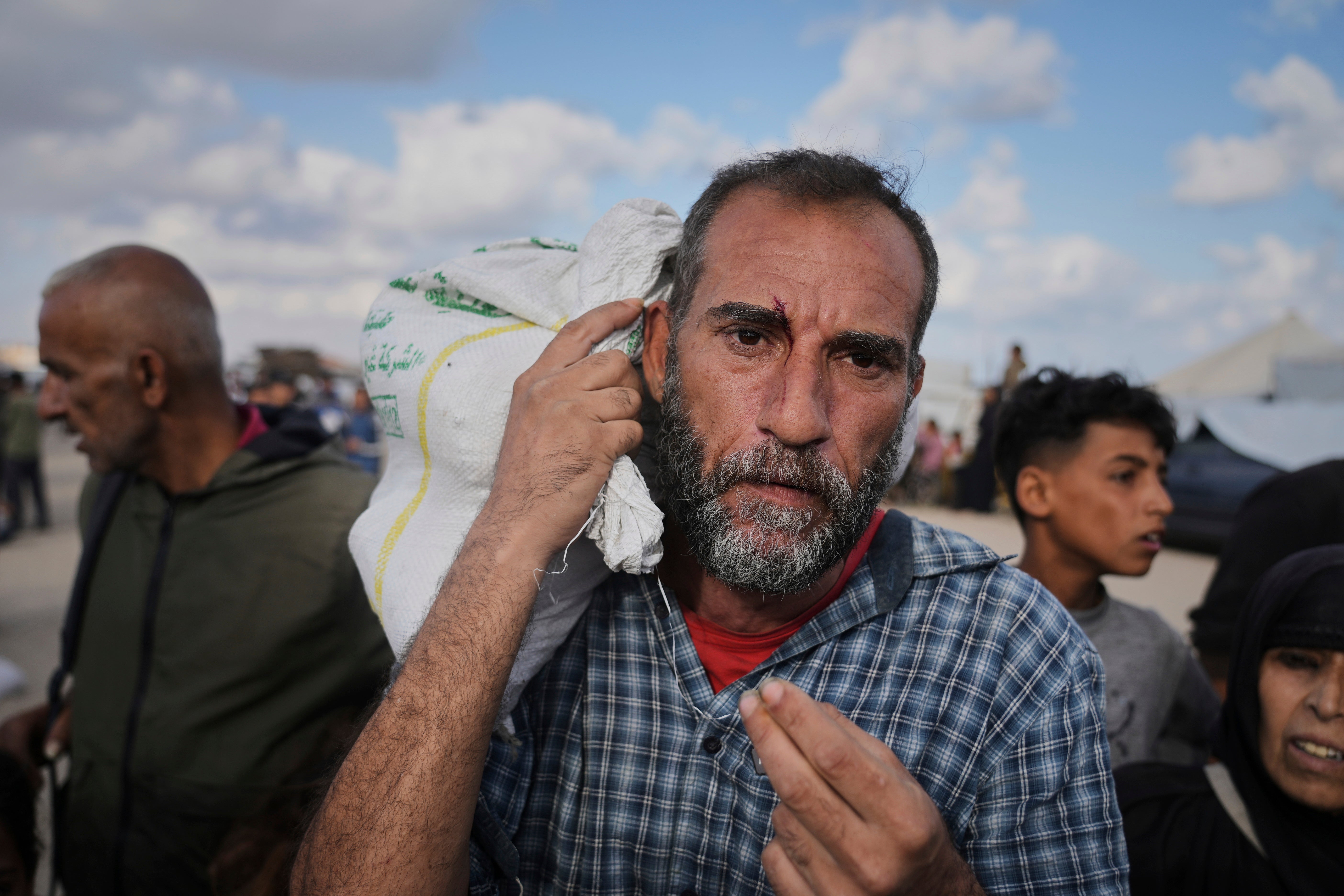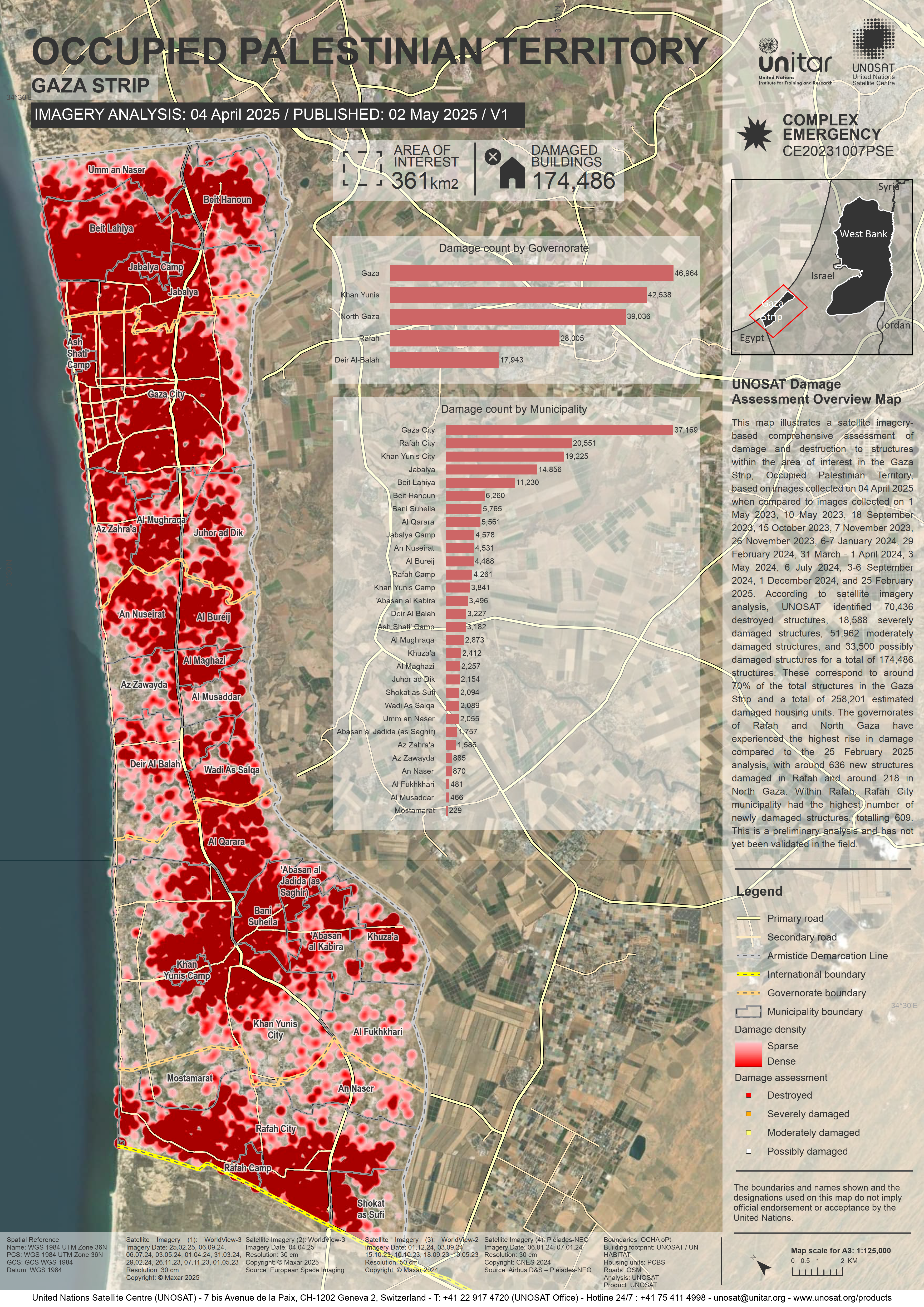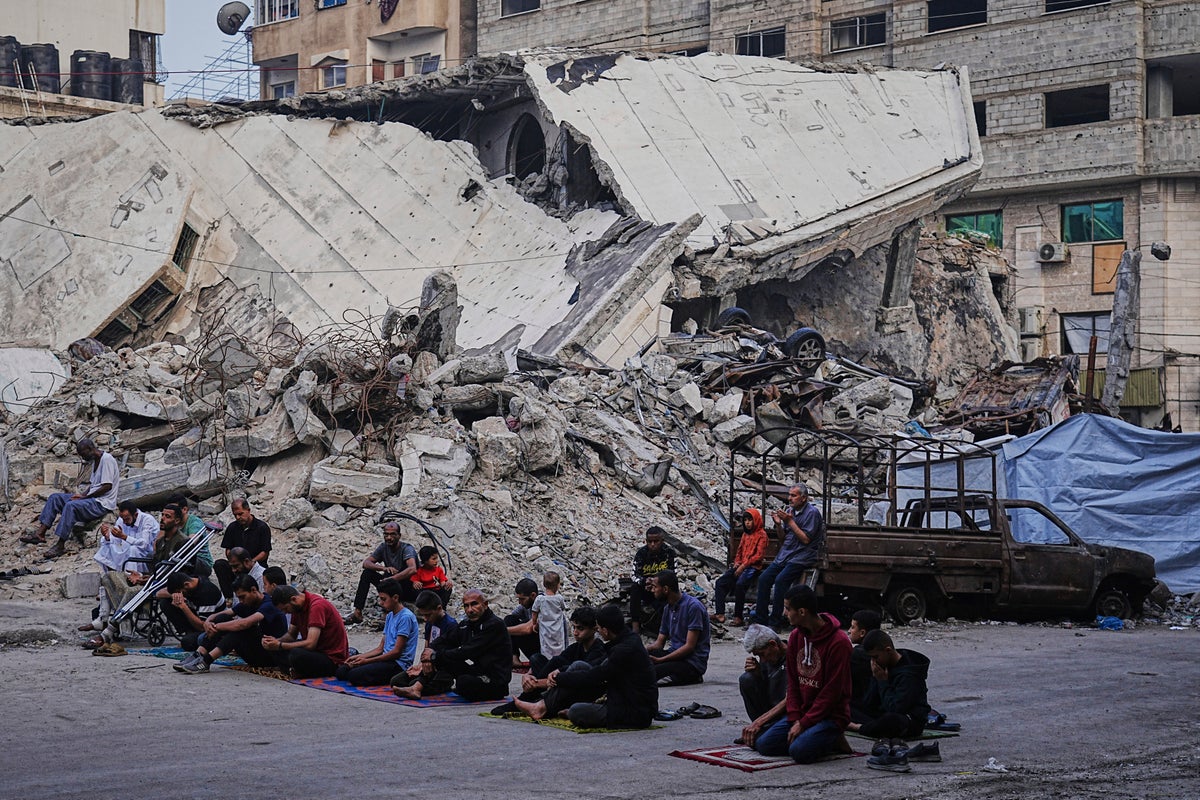It has been around 80 days since Israel launched “pre-emptive” strikes on Gaza in March, effectively ending a fragile ceasefire with Hamas and resuming the conflict.
Two months later, Benjamin Netanyahu’s government launched Operation Gideon’s Chariots, an intensification of military action in Gaza with the aim of taking control of the entire strip. It has seen mass evacuation orders and restricted flows of aid with widespread reports of food shortages.
The latest figures from the Hamas-run health ministry say that 54,607 Palestinians have been killed in Gaza and a further 125,341 people injured, since around 1,200 people were killed in the Hamas attacks on 7 October, 2023.
Since the ceasefire broke in mid-March, Israel’s attacks on Gaza have ramped up significantly, with around 1,500 strikes recorded. May has been the most intensive month since 7 October, according to conflict specialist non-profit ACLED (Armed Conflict Location and Event Data).

At the same time, Gaza has faced looming famine and an ongoing aid crisis. Aid was blocked for over two months from early March, with no food allowed to cross into Gaza; forcing bakeries and organizations like the World Food Kitchen to shutter their operations.
On May 19, Israel announced that aid would finally enter Gaza, but only through the newly-established, US-backed Gaza Humanitarian Foundation (GHF).
The first aid trucks entered Gaza on May 25, but only lasted a week before GHF paused operations on Tuesday after 58 Palestinians were killed near distribution centers in Southern Gaza. Aid distribution in Gaza was halted on Friday after the US and the GHF said overcrowding had made it unsafe to continue operations. It was again paused on Saturday after the GHF claimed it was facing threats from Hamas.
“In addition to escalating military operations throughout Gaza, the humanitarian situation has deteriorated even further with the opening of the US-backed Gaza Humanitarian Foundation (GHF),” conflict analyst Salma Eissa told The Independent.
“ACLED records at least three fatal incidents connected to GHF aid distribution centers in the final week of May alone, underscoring the rising level of insecurity surrounding aid delivery.”
The GHF has said it is working with other organisations to try and prevent further incidents. In an interview with ABC News, the new chief executive, Reverend Johnnie Moore, said: “I fundamentally disagree with the premise that our operation is somehow disproportionately imperilling people. I’m not doing this for anybody to die.”
How much aid is entering Gaza?
Israel blocked all aid from entering Gaza for nearly three months, between March 2 and May 20.
Over this period, the entire 2.1 million population of Gaza faced food shortages, with 500,000 people at risk of starvation, according to a report from UN-backed food security experts.
The prices for basic essentials spiked, with a 25kg bag of flour costing between $235 and $520, according to the UN.
In late May, the UN Secretary General António Guterres said that some 160,000 pallets of aid supplies (around 9,000 trucks) were ready and waiting to enter Gaza.
Even after the blockade ended, reports on how much aid has been entering Gaza is not entirely clear.
An average of 116 aid trucks entered Gaza every day before the blockade, according to BBC reports.
The GHF has overseen all distribution of aid since the end of the blockade, meaning that the UN and other humanitarian organisations are not able to track how much is being given out.
The GHF has said that it delivered approximately 5.8 million meals in the week since it began operations on distributing aid on 27 May. The lack of transparency and tight control over aid distribution means that these figures cannot be verified by third parties.
If these figures are correct, they are meant to feed Gaza’s entire 2.1 million population – meaning an average of less than three meals per person over a seven day period.
The GHF’s food packages are reported to contain rice, flour, canned beans, pasta and more; most of which require cooking equipment and access to clean water and fuel.

UN officials have also said that the limited amounts of aid they have been allowed to distribute is limited to flour, with no ready-to-eat meals.
After aid distribution resumed briefly on Thursday following a two-day pause, the GHF said it had distributed around 25,000 boxes of food amounting to roughly 1.5 million meals. But there were further pauses on Friday and into the weekend.
On Saturday, the GHF said it was unable to distribute any humanitarian aid because Hamas had issued “direct threats” against the organisation’s operations.
“These threats made it impossible to proceed today without putting innocent lives at risk,” the organization said in a statement. “GHF will not be deterred. We remain committed to safe, secure and independent aid delivery. We are actively adapting our operations to overcome these threats and fully intend to resume distributions without delay.”
A Hamas official told Reuters he had no knowledge of the alleged threats.
Israel accuses Hamas of stealing aid, hence its restrictions. The UN denies there is any systematic diversion away from civilians.
Intense conflict since the ceasefire
Last month marked a shift in Israel’s conflict strategy. Launched in May, Gideon’s Chariots aims to capture all of Gaza and establish a “sustained presence” in the enclave. It also involves the mass displacement of the Gaza population to tightly controlled areas, concentrated in the south.
Since March 18, when the ceasefire ended, 4,335 Palestinians have been killed in the Gaza strip, says the Hamas-run health ministry.
In this period, Israel has launched over 2,100 remote and explosive attacks (including air and drone strikes, shelling, missiles and landmines) on Gaza, according to ACLED’s databases; 77 per cent of which were air and drone strikes.
This brings the total number to 15,500 remote attacks in the 20 months since 7 October, with over 9,700 strikes. Over 60 per cent of these attacks have targeted civilians, according to ACLED records.
Israeli prime minister Benjamin Netanyahu denied that the military targeted civilians, in an address at the end of May, while the military itself has repeatedly said it is only targeting Hamas.
“The first lie that is put against us is that we are deliberately killing civilians,” he said. “We are texting civilians by the millions. Millions of text messages, millions of phone calls, cell phone calls, millions of pamphlets. Please get out because we are going to come in. And that’s why the ratio of non-combatants to combatants killed in the most dense urban warfare area in modern history is the lowest in the Gaza war.
“We are going after Hamas, we are not going after the civilian population, both in allowing it to leave the theaters of combat but by also supplying them with essential requirements. Food, water, medicine. We supplied them with 1.8m tons of food and aid.”
Hamas and Palestinian armed groups have launched seven rocket attacks on Israel since the end of the ceasefire, according to the same ACLED records.
The data is collected from news sources and official reports, and not independently verified. Figures should be taken as approximate, as more attacks may not have been recorded.
May saw 690 air and drone strikes, even more than the first month of Israel’s retaliation in October 2023 when 673 strikes were recorded, ACLED says.
“The post-ceasefire period brought on a significant escalation in hostilities, characterized by intensified airstrikes and expanded ground operations as well as a notable shift in Israel’s military strategy in Gaza,” Ms Eissa, Middle East research manager at ACLED, told the Independent.
“This escalation has been marked with a surge in air/drone strikes, with a level of intensity not recorded by ACLED since the early days of the war in 2023,”
“The announcement of Operation Gideon’s Chariots in May brought on a further sustained and intensifying pattern of violence in Gaza, as Israel launched a comprehensive military campaign and resumed ground operations in addition to their aerial bombardment campaign.”
These increased strikes were seen across Gaza but with high concentrations in Khan Younis. The Israeli Defence Forces (IDF) attributed many of the strikes in Khan Younis (37% of all strikes last month) to targeting Hamas terrorist hubs in the area; where senior Hamas leader Mohammed Sinwar was reportedly killed last week.
The Israeli military says it seeks to exert “tremendous pressure” on Hamas and expand “operational control”.
In a statement last month, Mr Netanyahu said: “We are engaged in massive fighting – intense and substantial – and there is progress. We are going to take control of all areas of the Strip, that’s what we’re going to do.”
Widespread destruction in Gaza
The Israeli military has also been carrying out controlled demolitions and bulldozing of infrastructure in Gaza, separate from the air strikes.
This includes destroying Hamas tunnels and command centers, but also hundreds of targeted explosions at residential buildings, hospitals, government buildings, shops, and more.
The actions echo statements made by Israeli officials, including finance minister Bezalel Smotrich, who vowed that “Gaza will be entirely destroyed”; while US President Donald Trump called Gaza a “demolition site” earlier this year, encouraging Palestinians to leave.
This destruction has increased significantly since the ceasefire ended, ACLED data reveals; with 191 instances of IDF-controlled property destruction recorded in Gaza since March alone.
Most of these properties are residential homes, primarily in Gaza City, Khan Younis and Rafah.
The exact scale of the damage is unknown, but the UN agency for Palestinian refugees (UNRWA) estimates that 92 percent of all residential homes in the Gaza Strip have been destroyed.

Meanwhile, satellite imagery analysis from the UN (UNOSAT) suggests that over 70,000 buildings have been entirely destroyed in the Strip; with a further 18,000 severely damaged, and 52,000 seeing moderate damage.
A further 81 percent of Gaza’s cropland has also been damaged by the conflict, according to UNOSAT’s latest report in April; significantly hindering the homegrown food supply amid widespread shortages.
And as the crisis continues to deepen, Israel faces ongoing international pressure.
On Wednesday, the UK joined 13 other countries in backing a UN Security Council resolution that called for an immediate ceasefire and for Israel to lift restrictions on aid.
But the move was vetoed by the US, on the basis that the resolution was not linked to the release of the remaining hostages taken on 7 October, did not condemn Hamas and did not insist the militant group disarm and withdraw from Gaza.




